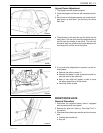
9P – 12 DOORS
DAEWOO M-150 BL2
The tailgate lock striker consists of a striker with two
screws that are threaded into a tapped, floating cage
plate located in the appropriate body pillar. This floating
cage plate allows the striker to be easily adjusted in or
out and up or down. The tailgate is secured in the closed
position when the tailgate lock fork snaps over and en-
gages the striker.
D109C578
Fore/Aft or In/Out Adjustment
An adjustment of the striker in the fore and aft or in and
out directions may be necessary for a number of reasons:
vehicle frame damage as the result of a collision, installa-
tion of new tailgate weatherstripping, customer com-
plaints of excessive windnoise, or difficulty in opening or
closing the tailgate. In order to adjust the tailgate striker in
an fore and aft or in and out direction, perform the follow-
ing procedure:
1. The tailgate must be properly aligned.
2. Loosen the striker screws.
3. The floating cage plate can be moved slightly using
the ends of the striker screws. Move the floating cage
plate to the desired position.
Notice: It is important to use a flat-end rotary file in or-
der not to damage the tapped floating cage plate. The
striker screws and the tapped floating cage plate are im-
portant attaching parts that could affect the performance
of vital components and systems.
D109C579
4. If proper adjustment requires that the floating cage plate
be moved more than is possible, use an electric hand
drill and a 3/8- inch rotary file with a flat head in order to
enlarge the body opening in the direction required.
5. Tighten the striker screws to the correct position.
6. Perform the up/down adjustment. Refer to “Up and
Down Adjustment” in this section.


















